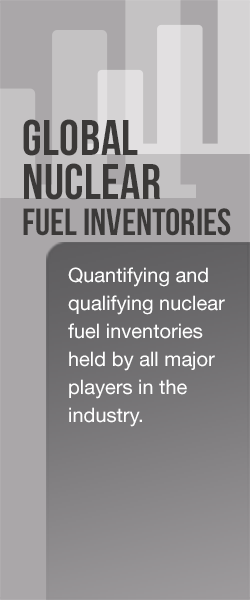Finding Fair Market Equilibrium
One of the questions we asked in our Winter 2020 UxC Market Survey was, “In what range do you view a fair market equilibrium price for uranium (in 2020 dollars per pound U3O8) over the next decade?” As seen in the chart below, none of the answers from survey respondents were terribly surprising, but there did seem to be general consensus among utilities, suppliers, and traders that spot uranium prices need to push higher in the years ahead to meet the projected growth in global uranium requirements and offset the loss of some current mines. While suppliers were generally more optimistic about the degree of price increase needed, their more bullish outlook only narrowly outstripped that of utilities.
As is well known, the uranium market became oversupplied following the Fukushima accident in 2011. Moreover, it clearly took too much time for suppliers to react to the new era of growing global inventories and falling prices amid continuing overproduction before they made difficult (but necessary) decisions to curtail production. In 2016, Cameco was one of the first suppliers to cut meaningful production, first at its U.S. operations and Rabbit Lake in Saskatchewan, followed later by the suspension of its majority owned McArthur River project in early 2018. In aggregate, Cameco’s production cuts resulted in the removal of ~24 million pounds U3O8 annually from the market. Kazatomprom also reduced Kazakh production significantly starting in late 2017 to 20% below the production target under subsoil use contracts for its mining enterprises. Although the production capacity from Kazakhstan’s mining projects have gradually increased to ~74 million pounds U3O8 over the last couple of years, Kazakh production totaled only 59 million pounds U3O8 in 2019.
In 2019, global uranium production totaled only 139 million pounds U3O8, which was 14% below the peak level of 162 million pounds U3O8 in 2016. With estimated global uranium demand of around 185 million pounds U3O8 in 2019, the difference between demand and primary production continued to be met by secondary supplies, a large component of which included commercial inventory drawdown and re-enriched tails/enricher underfeeding.
In the past two months, the market has changed dramatically due to the COVID-19 impacts on uranium mine operations. Although spot prices had languished in the $24-$26 range since March 2019, prices jumped starting in the last week of this March due to a series of production curtailments stemming from the COVID-19 pandemic, including Cameco’s suspension of Cigar Lake, a 4,000 tU (~10.4 million pounds U3O8) reduction to Kazakh production, and reduced mining operations in Namibia/South Africa. Prior to the pandemic, a number of market participants noted that spot prices would likely trend higher over the longer term, especially with Cameco continuing to buy spot material to meet forward sales commitments while it kept McArthur River offline. However, many expected that the drawdown of excess supplies would continue to take time before supply and demand fell into better balance.
The COVID-19 cutbacks are clearly speeding up this rebalancing process while also raising new questions about the robustness of the uranium supply chain. UxC has revised its forecast for 2020 mine output from 142 million pounds U3O8 down to a range of 120-125 million pounds U3O8. This large decline is hastening the reduction of low-cost mobile inventories that existed in the market prior to COVID-19 as producers as well as some utilities, traders, and financials purchase spot material to cover short-term and forward needs. Market implications related to the production suspensions have been quite evident, with the Ux U3O8 Price increasing 38% since March 16 to $33.30 as of May 18.
Meanwhile, Cameco has stated that health and safety will be the number one issue in deciding when to restart Cigar Lake, although it said it would look at commercial implications as well. Furthermore, when it comes to restarting the McArthur River mega project, Cameco has publicly said that it would need long-term uranium prices to exceed US$40 per pound U3O8.
This raises the question what price level is needed to incent future uranium production. UxC’s own analysis revealed that 2019 production of 139 million pounds U3O8 was at an estimated weighted average production cost of $25.27 per pound. Cameco’s 2019 financials reported that Cigar Lake production was at a cost of C$31.79 (~US$24.34) per pound U3O8, and Kazatomprom’s 2019 financials revealed an all-in sustaining cash cost (attributable C1 + capital cost) of US$11.84 per pound U3O8 for its Kazakh ISR projects. However, not all production registered such low costs, and future production – either from idled or new projects – is generally viewed as requiring higher prices to cover costs and provide an adequate return on investment.
Returning to our survey question, the highest number of utility respondents selected the $40-$45 range as a fair market equilibrium price for uranium, followed almost equally by the $45-$50 range and the $35-$40 range. Although there was some difference of opinion over the definition of a “fair price,” most utilities interpreted it as a price that would incentivize enough supply to meet required demand over the next decade. One utility respondent characterized a fair price as “one that provides a fair return on investment to the least most costly mine that can meet the greatest incremental demand.” However, some also viewed it as “the all-in sustaining cost for many of the next generation of mines,” which clearly ignores existing idle production capacity. For those utilities that selected the lowest price range of $25-$30, one comment was that this price level was “needed to burn off the excess inventory… eventually producers will need to stop producing to eliminate the excess.” Notably, we should remind that the vast majority of the responses to this survey came in well before the COVID-19 impacts on the market were known.
Other respondents, which includes producers, traders, and financials, also had the highest concentration of responses in the $40-$45 range, although a notable number also selected the $35-$40 lower level and the $45-$50 next higher level. Not surprisingly, two junior producers commented that the $45-$50 range was necessary to incent new production as well as restart shuttered supply.
One of the issues that UxC believes causes some misperception over a fair market equilibrium price between utilities and suppliers is how all-in production costs are viewed relative to a supplier’s desired sales price. For instance, Canada contains several promising uranium projects, including NexGen’s Arrow project, Denison’s Phoenix project, and Fission’s PLS project. Prefeasibility studies conducted over the past couple of years on each of these projects show all-in production costs, including initial capital costs, of C$17.23 (US$12.92) per pound U3O8 for Arrow, C$11.57 (US$8.90) per pound U3O8 for Phoenix, and C$26.60 (US$20.00) for PLS. Obviously, all three projects are in the developmental stages and costs are subject to change as more technical information is gained, but the projection of low future production costs and profits at near today’s prices sends a somewhat misleading message to utilities that the next generation of uranium projects will not need prices much higher than today. Also, the reality is that the accuracy of projected production costs under a prefeasibility study can vary as much as +/- 30%, whereas a definitive or bankable feasibility study are within 10% to 20% accuracy. Furthermore, while a developing project may have attractive estimated all-in production costs, entities financing the development of a promising project will not lend the required capital without a favorable rate of return on their investment that can only be achieved through higher sales prices.
Even among idle uranium projects, such as McArthur River, we witness a disparity between all-in production costs and expected future sales prices needed to return the project to production. In early 2019, Cameco released its 2019 McArthur River Operation Technical Report, wherein it noted an average operating cost for the McArthur River Joint Venture of C$14.97 (US$11.98) per pound over the life of the mine at a production rate of ~18 million pounds U3O8 per year. Adding in capital costs over the life of mine would still result in an average production cost of below US$20 per pound U3O8, leading many to believe that the project could return at a market price much lower than what Cameco has said it needs. However, what many market participants fail to consider is that aside from idle low-cost ISR capacity in Kazakhstan, nearly all other operational-ready projects on standby, as shown in UxC’s 2019 Uranium Production Cost Study (UPCS), cannot produce at a cost below $40 per pound U3O8, which gives the McArthur River project pricing power in a market with waning inventory supplies. It is well known that most U.S. projects cannot profitably operate at prices below $40 per pound U3O8, and even Paladin Energy indicated through its revised Langer Heinrich PFS last year that it would need prices higher than an all-in sustaining cost of $33 per pound U3O8 to restart the mine.
Moreover, there is often the argument that Kazakhstan has plenty of low-cost excess operational capacity given that ISR projects there are operating at 20% below the desired production targets under their individual subsoil use contracts. While the country is home to extensive low-cost resources, Kazatomprom has become more attuned to market factors in recent years, and there are a few Kazakh projects/deposits on the back end of their production lives, including Akdala and Zarechnoye. While UxC estimates that Kazakhstan had spare operating capacity of ~15 million pounds U3O8 prior to the recent ~10.4 million pounds U3O8 cut due to the COVID-19 pandemic, the bigger question is at what price would Kazatomprom consider ramping up production to utilize this spare capacity. The vast majority of Kazakh ISR production is low cost, as noted earlier, but similar to Cameco, Kazatomprom also realizes that most other operational-ready producers are not capable of producing profitably below $40 per pound in the near to medium-term. In fact, when asked what would be the incentive price for new Kazakh production at the 2020 BMO Global Metals and Mining Conference, Kazatomprom CEO Galymzhan Pirmatov said, “We don't really give you a price per se, but let's put it this way. We want basically McArthur to come back. When they’re making money at McArthur, we’re making a lot more money.”
The relatively low spot prices that generally remained in the $20s over the past four years were driven by suppressed demand, high inventories, and overproduction. The current COVID-19 pandemic is accelerating the drawdown of inventories, and has highlighted the potential of production to be further impacted by unforeseen events. Market prices are now slowly becoming more production-influenced as opposed to inventory-influenced. A future market equilibrium price will depend on several factors on the production-side, coupled with how demand evolves in the years ahead. However, one thing seems quite certain: the $24-$26 price plateau of the last year is a thing of the past. Ultimately, the invisible hand will govern where a fair market equilibrium price resides over the next decade, but in retrospect, the top selection of $40-$45 by utilities and others in our survey certainly seems within the realm of reason amid the current shifting supply and demand landscape.


